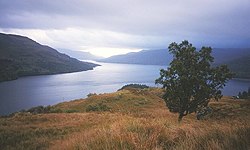Loch Katrine
| Loch Katrine | |
|---|---|

Above Stronachlachar, looking eastward along the length of the loch
|
|
| Location | Stirling area, Scotland |
| Coordinates | 56°15′16″N 4°30′56″W / 56.25444°N 4.51556°WCoordinates: 56°15′16″N 4°30′56″W / 56.25444°N 4.51556°W |
| Type | freshwater loch, reservoir |
| Basin countries | United Kingdom |
| Max. length | 13 km (8.1 mi) |
| Max. width | 1 km (0.62 mi) |
| Islands | Ellen's Isle, Factor's Isle |
Loch Katrine (![]() listen ; Scottish Gaelic: Loch Ceiteirein or Loch Ceathairne, pronounced [lˠ̪ɔx kʲʰeʰtʲəɾʲɛɲ]) is a freshwater loch and scenic attraction in the Trossachs area of the Scottish Highlands. It is within the district of Stirling. The loch is 13 kilometres (8.1 mi) long and 1 kilometre (0.62 mi) wide at the widest point and runs the length of Strath Gartney (Gaelic: Srath Ghartain). It is a popular destination for tourists and day visitors from Glasgow and nearby towns. The loch derives its name from the term cateran from the Gaelic ceathairne, a collective word meaning cattle thief or possibly peasantry. Historically this referred to a band of fighting men of a clan; hence the term applied to marauders or cattle-lifters, the most notorious of whom was Rob Roy MacGregor who was born at Glengyle House at the northern end of the loch.
listen ; Scottish Gaelic: Loch Ceiteirein or Loch Ceathairne, pronounced [lˠ̪ɔx kʲʰeʰtʲəɾʲɛɲ]) is a freshwater loch and scenic attraction in the Trossachs area of the Scottish Highlands. It is within the district of Stirling. The loch is 13 kilometres (8.1 mi) long and 1 kilometre (0.62 mi) wide at the widest point and runs the length of Strath Gartney (Gaelic: Srath Ghartain). It is a popular destination for tourists and day visitors from Glasgow and nearby towns. The loch derives its name from the term cateran from the Gaelic ceathairne, a collective word meaning cattle thief or possibly peasantry. Historically this referred to a band of fighting men of a clan; hence the term applied to marauders or cattle-lifters, the most notorious of whom was Rob Roy MacGregor who was born at Glengyle House at the northern end of the loch.
It is the fictional setting of Sir Walter Scott's poem The Lady of the Lake and of the subsequent opera by Gioachino Rossini, La donna del lago.
Robert Roy MacGregor was born at the head of the loch.
Loch Katrine is now owned by Scottish Water, and has been the primary water reservoir for much of the city of Glasgow and its surrounding areas since 1859. The water level has been artificially raised by around 1.8 metres (5.9 ft) - the loch can be drawn down by a maximum of 2 metres (6.6 ft) in order to provide gravitational flow to the Milngavie water treatment works via two 41 kilometres (25 mi) long aqueducts and 21 kilometres (13 mi) of tunnel. Milngavie itself is situated at almost 122 metres (400 ft) above sea level - sufficient to provide adequate water pressure to the majority of the city without the need for pumping. The system can deliver up to 230,000,000 litres (51,000,000 imp gal) a day. Construction was started in 1855 and the works was opened by Queen Victoria in 1859. The aqueduct project was built under the guidance of the eminent civil engineer John Frederick Bateman (1810–1889), an example of his engineering prowess that can still be seen working today. The second aqueduct was opened in 1901.
...
Wikipedia
